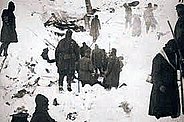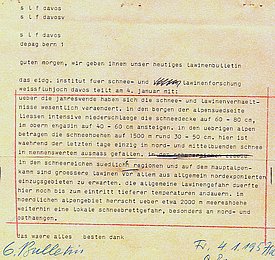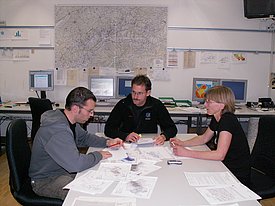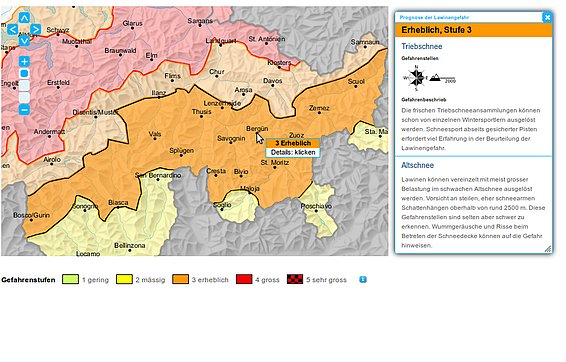When the Commission for Snow and Avalanche Research was established in 1931, its main focus was conducting systematic research into avalanches. The Swiss Skiing Association first used the Commission's observations to issue information in the press and on the radio about the weekend snow conditions in the Swiss Alps in the winter of 1936/37.
The strategic military importance of the Swiss Alps in the Second World War increased the political significance of avalanche research. The experience of the First World War, during which around 7,000 - 8,000 soldiers are thought to have perished in avalanches, had not been forgotten. In addition, an avalanche above Lenk in 1939 had buried an entire company of mountain troops, fuelling interest from military leaders in the Commission's work. At last, the Commission's call for personnel and financial support from the armed forces was given a sympathetic hearing. As the army's collaboration was stepped up, military officers started receiving avalanche training from employees of the Weissfluhjoch research site. In 1940, the military, working closely with the Commission, established an avalanche warning service with observation stations in various locations across Switzerland, thereby institutionalising avalanche warnings for the armed forces.
From a military to a civil avalanche service ¶
Following the end of the Second World War, the WSL Institute for Snow and Avalanche Research (SLF) spawned by the Commission took over responsibility for avalanche warnings on 1 October 1945 and established the civil avalanche warning service. By 1950, 20 observers were providing weather, snow and avalanche data to the avalanche warning service. Each week, the SLF issued an avalanche bulletin on the radio and in the press. This information was welcomed by both the emerging winter sports resorts and the agencies responsible for public safety. After a particularly bad winter for avalanches in 1950/51, structural avalanche protection and the avalanche warning service were both expanded. An additional 30 observers were hired to telex daily reports to Davos, and the number of avalanche bulletins each winter doubled to around 40. Soon this information was also available as a recorded message over the phone.
The European Danger Scale ¶
Although a European Avalanche Warning Services (EAWS) working group was established back in 1983 to improve cooperation across national borders, for a long time individual countries continued to use a variety of danger scales for avalanche warnings with six to eight danger levels. In 1994, the EAWS introduced the five-level European Danger Scale. This adoption of a uniform scale represented a breakthrough for international avalanche warning services and simplified matters for all parties involved.
From status report to forecast ¶
Until the winter of 1996/97, the SLF was issuing an avalanche bulletin two to three mornings a week on average. Subsequently, the service was steadily expanded. First, the national avalanche bulletin began coming out daily at 5 pm, in the form of a forecast for the next 24 hours. Then, seven regional avalanche bulletins were gradually introduced in the years leading up to the winter of 2002/03 - also thanks to the financial contribution of the Federal Office for the Environment FOEN. Issued at 8 am, they gave an update on the day's forecast.
Graphic avalanche bulletin twice a day in four languages ¶
Since the bulletin was revamped in the winter of 2012/13, it has been published twice a day in all four languages used by the SLF (German, French, Italian and English), for all the forecast areas. This was only made possible by various elaborate systems developed at the SLF, including a fully automatic translation tool. Since that time – when recorded phone forecasts were scrapped – the bulletin has systematically focused on capitalising on the graphical features provided by the internet and smartphones. From the winter of 2006/07 onwards, avalanche bulletins were issued sporadically for the Jura. Since the winter of 2017/18, the Jura has been a permanent part of the avalanche bulletin and is assessed in every issue if there is enough snow.
Continuous improvements have been made to not only the products but also the basic infrastructure. The backbone for this is made up of a dense network of local observers and, since the end of the 1990s, an extensive network of automatic Intercantonal Measurement and Information System (IMIS) stations. This was supplemented in the winter of 2010/11 by the mAvalanche mobile observer network, to which any winter sports enthusiast has been able to contribute using Reply Public since the winter of 2015/16. Last but not least, the avalanche warning service is also reaping the rewards of steadily improving weather models developed by MeteoSwiss.
Continuous development ¶
Today, the avalanche bulletin is constantly being further developed and the avalanche forecasters are increasingly supported by AI models developed at the SLF. Since the winter of 2022/23, the danger levels have been subdivided with intermediate levels. From autumn 2023 onwards, the avalanche bulletins for large summer snowfalls will be published with a hazard map, just as in winter. Text-only bulletins are thus finally a thing of the past. The SLF avalanche bulletin will now be published on WhiteRisk (app and website).



